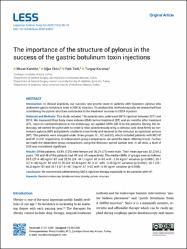The importance of the structure of pylorus in the success of the gastric botulinum toxin injections
Özet
Introduction: In clinical practices, our success rate proved lower in patients with hypotonic pylorus who
underwent gastric botulinum toxin A (GBTA) injection. To analyze this methodologically, we researched how
considering the pyloric structure contributes to the treatment success in GBTA injection.
Materials and Methods: This study included 196 patients who underwent GBTA injection between 2017 and
2018. We measured their body mass indexes (BMI) before treatment (BT) and six months after treatment
(AT). Upon no contraindications in the endoscopy, we applied GBTA 200 U to the patients. During the endoscopy, we named the pylori able to strain & relax spontaneously or by a stimulus and close firmly as normotonic pylorus (NP) and patients unable to close firmly and respond to the stimulus as hypotonic pylorus
(HP). The patients were analyzed under three groups: G1, G2 and G3, which included patients with NP, HP
and NP (+) HP, respectively. In independent group comparisons, we used the Mann-Whitney U test. Further,
we made the dependent group comparisons using the Wilcoxon paired sample test. In all tests, a level of
0.05 was considered significant.
Results: Of the patients, 63.8% (125) were female and 36.2% (71) were male. Their mean age was 32.27±9.2
years. 148 and 48 of the patients had NP and HP, respectively. The median BMIs of groups were as follows:
35.5 (27.4–48) kg/m2
BT and 32.55 (24–44.1) kg/m2
AT in G3 with -2.95 kg/m2
variation (p=0.048*), 35.7
(27.4–48) kg/m2
BT and 32.35 (24–42.8) kg/m2
AT in G1 with -3.35 kg/m2
variation (p=0.036*), 35.1 (29–
46.2) kg/m2
BT and 34.15 (27.9–44.1) kg/m2
AT in G2 with -0.95 kg/m2
variation (p=0.098).
Conclusion: We recommend administering GBTA injection therapy especially to the patients with NP.
Cilt
27Sayı
1Bağlantı
https://hdl.handle.net/11363/6241Koleksiyonlar
Aşağıdaki lisans dosyası bu öğe ile ilişkilidir:


















